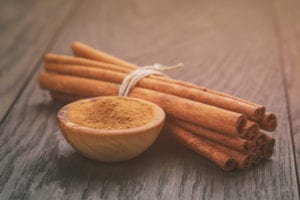Written by Joyce Smith, BS. Sixteen weeks of cinnamon supplementation significantly improved body composition and parameters of metabolic syndrome in Asian Indians.
 Type 2 diabetes (T2DM) and cardiovascular disease (CVD) have doubled in India during the past three decades and early onset and severe CVD is frequently seen 1. Individuals with metabolic syndrome are at five times greater risk of developing T2DM and three times more likely to have a heart attack or stroke compared to people without it 2. These individuals are also twice as susceptible to die from T2DM and heart attack or stroke 2. Almost 20–30% of the population in urban cities of India has metabolic syndrome 3
Type 2 diabetes (T2DM) and cardiovascular disease (CVD) have doubled in India during the past three decades and early onset and severe CVD is frequently seen 1. Individuals with metabolic syndrome are at five times greater risk of developing T2DM and three times more likely to have a heart attack or stroke compared to people without it 2. These individuals are also twice as susceptible to die from T2DM and heart attack or stroke 2. Almost 20–30% of the population in urban cities of India has metabolic syndrome 3
Previous studies have suggested a potential role of cinnamon and its components in improving the risk factors associated with metabolic syndrome 4,5; prompting Jain et al to design a 16-week randomized, placebo-controlled, double-blind trial 6 to explore the effect of cinnamon supplementation on the body composition and metabolic parameters of Asian Indians with metabolic syndrome. One hundred sixteen individuals with metabolic syndrome were randomized to two dietary intervention groups: cinnamon [6 capsules (3g) daily] or wheat flour placebo [6 capsules (2.5g) daily]. The following measures were assessed at baseline and after 16 weeks of cinnamon supplementation: body composition (body weight, body mass index (BMI), waist circumference (WC), waist-hip ratio, percentage body fat, systolic (SBP) and diastolic blood pressure (DBP), and metabolic parameters [fasting blood glucose (FBG), HbA1c, lipid profile, and high-sensitivity C-reactive protein (hs-CRP)].
At baseline, both groups were similar; however, the cinnamon group had significantly greater mean weight (P = 0.009) and BMI (P = 0.010) compared to the placebo group. At sixteen weeks, significant improvements were evident in the cinnamon group relative to the control. Decreases were seen in the following parameters: weight (3.0 kg, P = 0.001), BMI (1.3 kg/m2, P = 0.001), WC (4.8 cm, P = 0.002), waist-hip ratio (0.03, P = 0.028), body fat (3% decrease, (P = 0.011), SBP (8.3 mmHg, P = 0.001), DBP (6.9 mmHg, P = 0.001), FBG (0.5 mmol/L, P = 0.001), HbA1c (2.6 mmol/mol, P = 0.023), postprandial blood sugar (0.6 mmol/L, P = 0.030), total cholesterol (0.42 mmol/L, P = 0.006), triglycerides (0.20 mmol/L, P = 0.010), LDL, 0.37 mmol/L P = 0.003), and ratio of LDL to HDL (0.72 P = 0.001). In addition, the cinnamon group had a significant increase of 0.05 mmol/L in HDL compared to the placebo group (P = 0.035). Hs-CRP did not change significantly in either groups; however, the prevalence of MetS was significantly reduced by 34.5% in the cinnamon group compared to 5.2% in the placebo group.
Overall, there was a beneficial effect of 3 g/day cinnamon for 16 weeks in Asian Indians with MetS, as evidenced by a significant decrease in hyperglycemia, body weight, total adiposity, abdominal adiposity, and serum lipid levels compared to placebo.
Future studies should evaluate the benefits of varying doses of cinnamon over longer periods of time and with larger intervention groups. Also, the obese study population does not allow for generalization to a leaner population.
Source: Jain, Sonal Gupta, Seema Puri, Anoop Misra, Seema Gulati, and Kalaivani Mani. “Effect of oral cinnamon intervention on metabolic profile and body composition of Asian Indians with metabolic syndrome: a randomized double-blind control trial.” Lipids in health and disease 16, no. 1 (2017): 113.
© The Author(s). 2017 Open Access Creative Commons Attribution 4.0 International License (http://creativecommons.org/licenses/by/4.0/) which permits unrestricted use, distribution, and reproduction in any medium, provided you give appropriate credit to the original author(s) and the source, provide a link to the Creative Commons license, and indicate if changes were made. The Creative Commons Public Domain Dedication waiver (http://creativecommons.org/publicdomain/zero/1.0/) applies to the data made available in this article, unless otherwise stated.
Click here to read the full text study.
Posted March 4, 2019.
Joyce Smith, BS, is a degreed laboratory technologist. She received her bachelor of arts with a major in Chemistry and a minor in Biology from the University of Saskatchewan and her internship through the University of Saskatchewan College of Medicine and the Royal University Hospital in Saskatoon, Saskatchewan. She currently resides in Bloomingdale, IL.
References:
- Misra A, Ramchandran A, Jayawardena R, Shrivastava U, Snehalatha C. Diabetes in south Asians. Diabetic Medicine. 2014;31(10):1153-1162.
- Paoletti R, Bolego C, Poli A, Cignarella A. Metabolic syndrome, inflammation and atherosclerosis. Vascular health and risk management. 2006;2(2):145.
- Misra A, Khurana L. Obesity and the metabolic syndrome in developing countries. The Journal of Clinical Endocrinology & Metabolism. 2008;93(11_supplement_1):s9-s30.
- Anderson RA, Broadhurst CL, Polansky MM, et al. Isolation and characterization of polyphenol type-A polymers from cinnamon with insulin-like biological activity. Journal of agricultural and food chemistry. 2004;52(1):65-70.
- Wang JG, Anderson RA, Graham III GM, et al. The effect of cinnamon extract on insulin resistance parameters in polycystic ovary syndrome: a pilot study. Fertility and sterility. 2007;88(1):240-243.
- Jain SG, Puri S, Misra A, Gulati S, Mani K. Effect of oral cinnamon intervention on metabolic profile and body composition of Asian Indians with metabolic syndrome: a randomized double-blind control trial. Lipids in health and disease. 2017;16(1):113.
